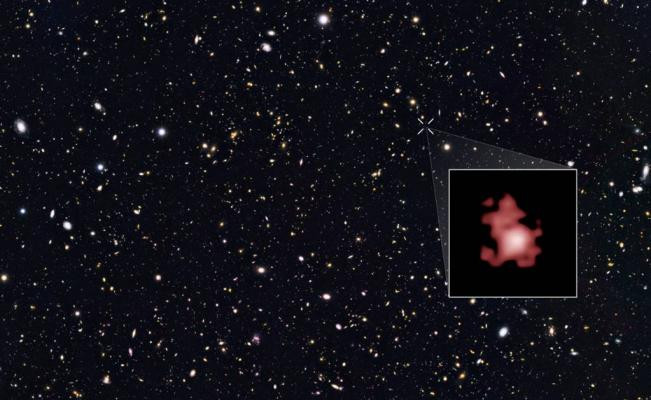Discover the oldest galaxy in the universe
The US Aerospace Agency's Hubble Telescope set a new record when finding GN-z11, the most distant galaxy located 13.4 billion light-years from Earth.
According to the International Business Times, because the light emitted from galaxies takes billions of years to reach Hubble, this giant telescope is "looking back" to the beginning of the universe.
"We have taken a big step back in time, beyond what we expected in Hubble. We can observe GN-z11 when the universe is only 3% of today's age," said the researcher. rescue Pascal Oesch at Yale University, USA, said. The findings were published yesterday in the journal Astrophysics.

The galaxy GN-z11 is 13.4 billion light-years away from Earth.(Photo: NASA).
The most distant galaxy record changed many times in the past year. Keck Observatory in Hawaii, USA, found the EGS-zs8-1 galaxy 13.1 billion light-years from Earth. The EGS-zs8-1 holds the oldest galaxy in the universe until researchers at the California Institute of Technology (Caltech) can observe the EGS8p7 galaxy at a distance of 13.2 billion light-years. With the new discovery, GN-z11 officially holds the record as the most distant and oldest galaxy in the universe.
The researchers used Hubble's Wide Field Camera 3 wide-range camera to determine the distance of GN-z11.
Measuring changes in the wavelength of the red spectrum according to the expansion of the universe can help scientists find a star or galaxy far away from Earth.
After identifying the distance, astronomers used NASA's Spitzer space telescope data to delve into the ancient galaxy. GN-z11 is 25 times smaller than the Milky Way, but undergoes 20 times faster star formation.
"It is interesting to know that such a large galaxy was present only after the first stars formed 200-300 million years," said researcher Garth Illingworth of the University of California, Santa Cruz.
The distance of GN-z11 is said to be close to the edge of Hubble's field of observation. Galaxies of the same age or older will certainly be discovered by the successor version, the James Webb space telescope."The new study shows the Webb telescope will certainly find many galaxies from the youngest to the oldest , " Illingworth said.
- Discover the oldest universe spiral galaxy
- Discover the oldest stars in the universe?
- Hubble telescope detects the oldest galaxy
- New candidate for the throne
- Find the oldest cluster of galaxies
- Discover the farthest galaxy ever
- Discover the lightest galaxy
- The galaxy was discovered when the universe was 650 million years old
- EGSY8p7 Detection - The oldest galaxy ever found
- Discovering the galaxy most life-long
- What's interesting about the farthest galaxy in the universe?
- Discovered the merger of galaxies 13 billion years ago
 Van Allen's belt and evidence that the Apollo 11 mission to the Moon was myth
Van Allen's belt and evidence that the Apollo 11 mission to the Moon was myth The levels of civilization in the universe (Kardashev scale)
The levels of civilization in the universe (Kardashev scale) Today Mars, the sun and the Earth are aligned
Today Mars, the sun and the Earth are aligned The Amazon owner announced a secret plan to build a space base for thousands of people
The Amazon owner announced a secret plan to build a space base for thousands of people New giant galaxy discovered hidden in the 'blind zone' of the Milky Way
New giant galaxy discovered hidden in the 'blind zone' of the Milky Way  11 billion year old ghost appears in stunning space-time bending photo
11 billion year old ghost appears in stunning space-time bending photo  The most terrifying 'cannonball' ever flew past NASA's telescope
The most terrifying 'cannonball' ever flew past NASA's telescope  Galaxy 97% old, the size of the universe, appears before the eyes of Earthlings for the first time
Galaxy 97% old, the size of the universe, appears before the eyes of Earthlings for the first time  Revealing the 'time-traveling' galaxy from where the universe began
Revealing the 'time-traveling' galaxy from where the universe began  Spectacular galaxy merger captured by James Webb Telescope
Spectacular galaxy merger captured by James Webb Telescope 